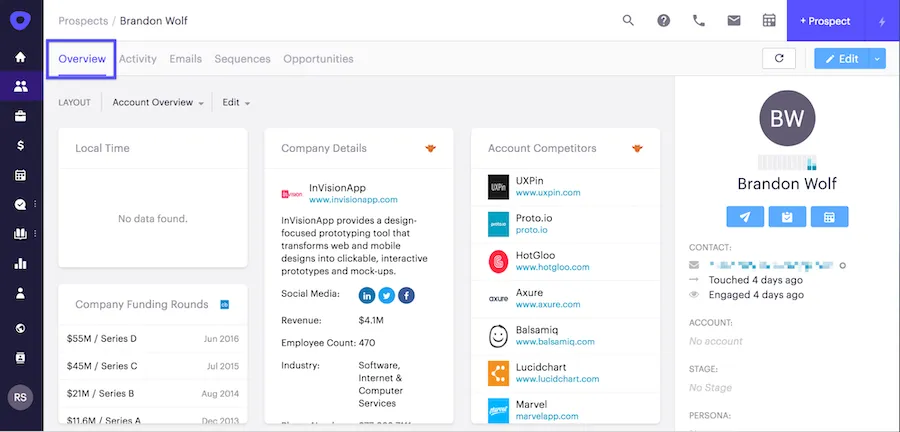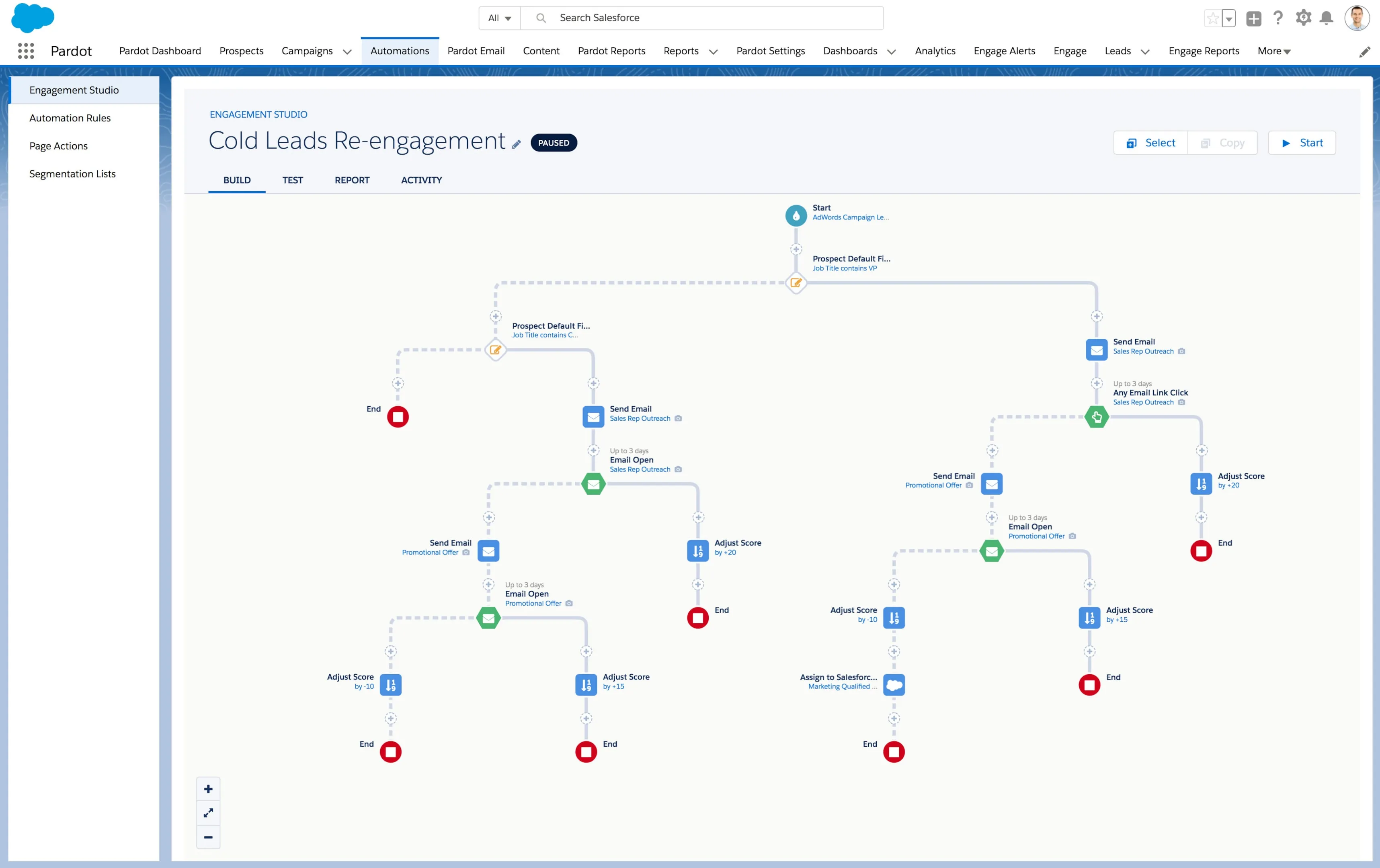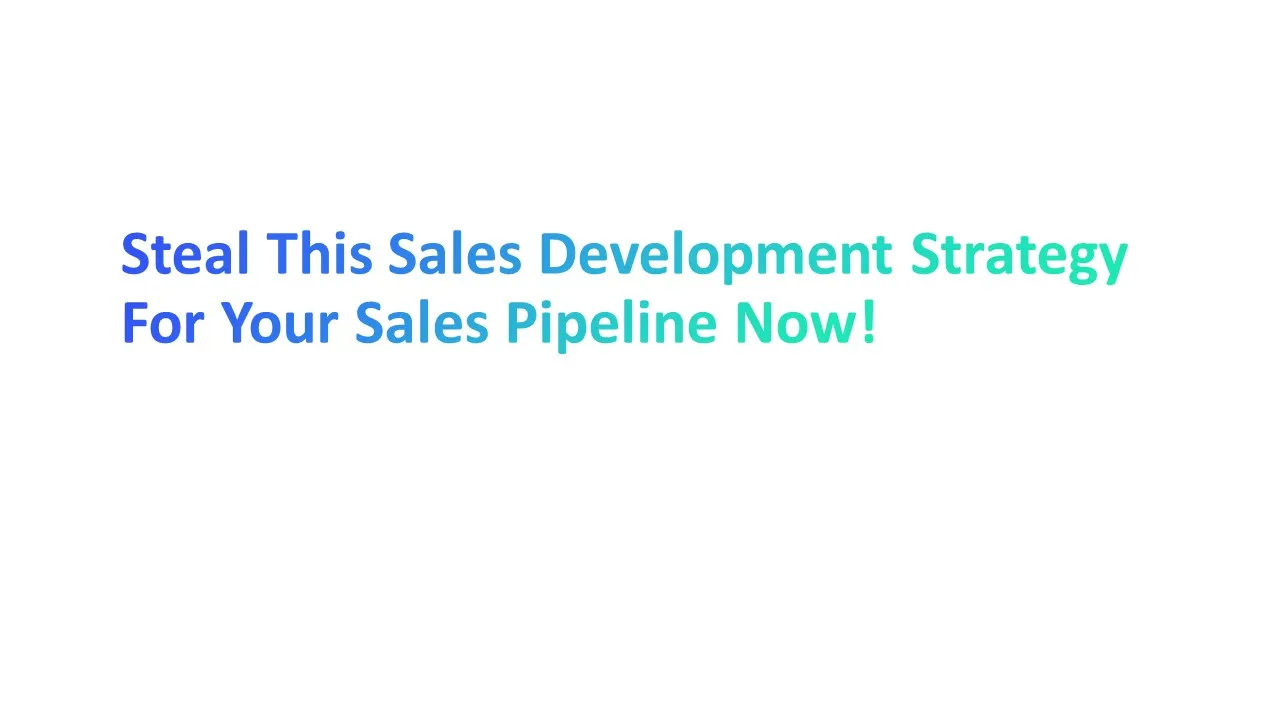If you're serious about improving your sales pipeline, then nailing your sales development strategy is non-negotiable.
Did you know that companies with a defined sales development process see a 33% higher closing rate?
A solid strategy isn't just about generating leads; it's about those qualifying leads, the right ones, nurturing them, and aligning every step with your sales cycle.
What is a Sales Development Strategy?

A sales development strategy is a plan a sales development manager has designed to streamline your sales process and generate revenue by identifying and engaging with the right prospects.
This strategy focuses on finding potential customers, qualifying them as leads, and guiding them through the sales pipeline.
Why Sales Development Team is Important?
An effective sales development team can significantly improve your company's sales performance. A successful sales development strategy and team is essential for laying the groundwork in the sales process. Here’s a few reasons why they matter:
- Lead Qualification: The team filters out unqualified leads, allowing your sales reps to focus on closing deals. Sales development teams play a pivotal role in streamlining the lead generation process.
- Time Efficiency: By handling the initial stages of the sales cycle, they save time for the account executives who then concentrate on high-priority tasks.
- Consistency: The team ensures a steady flow of qualified leads into the sales funnel, maintaining consistent sales activity.
- Improve Sales Rep Productivity: By freeing up sales reps from initial outreach tasks, the team enables them to focus on closing sales, improving their productivity and effectiveness.
- Support Scalability: A dedicated sales development team allows your business to scale efficiently, handling increased lead volumes without compromising on quality or performance.
Sales Development Strategy to Achieve Sales Targets

1. Clear Targeting and Segmentation
Clear targeting and segmentation involve pinpointing your ideal customers—those who are most likely to benefit from your product or service.
Why it’s important:
By focusing your sales activities on the right leads, you save time and resources. Your sales team can concentrate on prospects who are more likely to convert, increasing your chances of closing deals and achieving your sales targets.
How to implement:
- Begin by defining your ideal customer profile (ICP).
- Use sales intelligence tools to gather data about potential customers.
- Segment these leads based on criteria like industry, company size, or buying behavior. This allows you to tailor your approach, making your outreach more effective.
2. Prioritize Lead Qualification
Lead qualification is the process of assessing whether a lead is a good fit for your product or service. This helps sales leaders determine which leads qualify prospects and are worth pursuing.
Why it’s important:
Not all leads are equal. Some may be ready to buy, while others may not have the budget or authority to make a decision. By prioritizing leads, your sales development team can focus on those most likely to convert, improving sales org' efficiency and speeding up the sales cycle.
How to implement:
- Use a lead scoring system to rank your leads.
- Factors to consider include their level of engagement, budget, and decision-making power. For instance, if a lead has interacted with your content multiple times or requested a demo, they likely have a higher intent to purchase and should be prioritized.
- Tools like CRM software can help automate and track this process.
3. Implement Lead Nurturing System
Lead nurturing and lead management often involves building and maintaining relationships with leads over time, ensuring they receive the right information and support as they move through the sales funnel.
Why it’s important:
Many leads are not ready to buy immediately. A nurturing system keeps them engaged, gradually moving them closer to making a purchase. This consistent interaction helps maintain interest and trust of prospective customers in your product.
How to implement:
- Create a series of targeted communications, such as emails or phone calls, that guide your leads through their buying journey.
- Start with educational content that addresses their pain points, then introduce how your product can solve these issues.
- Regular follow-ups are crucial, but they should be spaced out to avoid overwhelming the lead. Sales engagement tools can help manage and automate these interactions.
4. Shorten Sales Cycle with Targeted Efforts
Shortening the sales cycle means reducing the time it takes to turn a lead into a paying customer. This can be achieved by focusing your efforts on the most promising leads.
Why it’s important:
The faster you can identify prospects and close deals, the more sales you can make in a given time. A shorter sales cycle means your sales team spends less time on unqualified leads. This allows them to focus more on prospects likely to convert, which increases overall productivity in outbound sales.
How to implement:
- Identify the leads that are most likely to buy, using tools like lead scoring and sales intelligence.
- Focus your resources on these high-potential prospects. Additionally, use a streamlined sales process to guide these leads through the funnel efficiently.
5. Align Sales and Marketing
Aligning your sales and marketing team means ensuring both your sales development rep and marketing departments work together toward the same goals. They should share information, collaborate on strategies, and support each other.
Why it’s important:
When sales and marketing are aligned, they can work together more effectively. Marketing can produce high-quality leads with a better chance of conversion, while sales can offer insights to refine marketing strategies. This collaboration leads to better sales development and higher conversion rates.
How to implement:
- Hold regular meetings between the sales development team and the marketing team to discuss goals, strategies, and progress.
- Use shared tools like a CRM software to track leads and measure the effectiveness of your campaigns.
- Ensure that both teams have a clear understanding of the target audience and the best ways to engage them.
6. Use Data to Optimize Strategy
Using data to optimize your sales development strategy means making decisions based on real numbers and facts rather than guesswork. This involves analyzing data from past sales, customer behavior, and market trends.
Why it’s important:
Data-driven decisions are more likely to be accurate and effective. By understanding what works and what doesn’t, you can refine your strategy to improve results. This can help you achieve your sales goals and targets more consistently.
How to implement:
- Regularly review data from your sales pipeline to identify trends and areas for improvement.
- Use sales tools to gather insights into customer behavior and preferences.
- Adjust your approach based on this information, such as changing how you qualify leads or where you focus your efforts. This will help ensure that your strategy is always evolving and improving.
7. Encourage Sales Training
Sales training means providing your sales team with the skills and knowledge they need to succeed. This includes understanding your products, using sales strategies to generate interest, mastering the sales process, and learning how to handle customer objections.
Why it’s important:
Well-trained, sales teams and reps are more confident and effective. They know how to approach potential customers, address their needs, and close deals. Training also helps your team stay updated with the latest sales techniques and tools, which is crucial in a constantly changing market.
How to implement:
- Regularly schedule training sessions for your sales development team.
- Use a mix of online courses, workshops, and role-playing exercises to keep things engaging.
- Encourage feedback and make training an ongoing part of your sales development strategy. For example, after a training session on handling objections, have your team practice with real-life scenarios to reinforce what they've learned.
8. Track Key Performance Metrics
Key performance metrics are numbers that help you measure how well your sales development strategy is working. These various operational metrics might include the number of leads generated, the conversion rate, or the time it takes to close a deal.
Why it’s important:
By tracking these metrics, you can see what’s working and what’s not. This enables you to base decisions on data and tweak your strategy to enhance outcomes.
For instance, if you notice that your conversion rate of inbound leads, is low, you might need to focus more on lead qualification or sales engagement efforts.
How to implement:
- Use CRM software to track and analyze your key metrics.
- Set clear goals for your sales team and regularly review progress.
- Share the results with your team and discuss any changes that might be needed. For instance, if the data shows that certain types of leads convert better, focus more on targeting those leads in your sales process.
How to Align Sales Development Process with your Sales Cycle

1. Map Out Your Sales Cycle
Understanding your sales cycle is crucial. The sales cycle represents the journey a customer takes from the first interaction to making a purchase.
Here’s how you can map it out:
- Identify the Stages: Break down your sales cycle into clear stages. These could include stages like lead generation, lead qualification, and closing sales.
- Analyze Past Data: Look at historical data to see how long each stage typically takes. For example, if it usually takes 10 days to qualify a lead, you know how to pace your sales development efforts.
- Involve Your Team: Discuss the stages with your sales development team to ensure everyone understands the process.
2. Tailor Lead Qualification Criteria
Once your sales cycle is mapped, it’s important to tailor your lead qualification criteria. This ensures that your sales development reps are focusing on the leads most likely to convert.
Here’s how you can do it:
- Define Ideal Customer Profiles: Use data to identify traits that your best customers share. These could include industry, company size, or specific pain points. This helps in refining your sales development process.
- Create a Scoring System: Develop a scoring system to rank leads based on how closely they match your ideal customer profile. For example, give more points to leads that fit your sales development strategy and fewer to those that don’t.
- Regularly Review and Adjust: Keep an eye on your lead qualification criteria. Adjust them as needed based on what’s working and what’s not. For example, if you notice that leads from a certain industry are closing faster, make sure your sales reps prioritize them.
3. Adapt Outreach Strategies to Sales Cycle Stages
Your outreach strategy should match where the customer is in the sales cycle. This means you need to change how you talk to potential customers depending on what stage they’re in.
Here’s how:
- Early Stage (Awareness): At the beginning of the sales cycle, your focus should be on educating potential customers. Use emails, social media, and blog posts to introduce your product and explain how it solves their problems.
- Middle Stage (Consideration): As customers move to the middle stage, they are comparing options. This is when you should share case studies, customer testimonials, and detailed product information.
- Late Stage (Decision): At this point, customers are ready to make a decision. Your outreach should be direct and focused on closing the deal. Offer demos, free trials, or special discounts to encourage them to choose your product.
4. Handoff Between Sales Development and Sales Team
The handoff between the sales development team and the sales team is a critical moment. If done poorly, it can lead to missed opportunities.
Here’s how to make the handoff smooth:
- Clear Criteria for Qualified Leads: Make sure your sales development reps know exactly when a lead is ready to be passed to the sales team. Use criteria like engagement level, budget, and decision-making authority to qualify leads.
- Document Everything: Before handing off a lead, ensure that all important information is documented. This includes the lead’s needs, concerns, and interactions with the sales development representative.
- Regular Communication: Keep the lines of communication open between the sales development team and the sales team. Regular meetings help ensure that everyone is on the same page and that leads are being handled effectively.
5. Integrate Sales Intelligence
Integrating sales intelligence tools into your sales development process can make a big difference. Sales intelligence involves using data to learn more about your potential customers.
Here’s how you can do it:
- Gather Information: Use sales intelligence tools to collect data about your leads. This data might include company size, industry, or recent news about the company. The more you know, the better you can tailor your approach.
- Analyze the Data: Once you have the data, analyze it to find patterns or important details. Your sales development team can use this information to craft personalized messages that resonate with the lead's current needs.
- Act on Insights: Use the insights from your analysis to guide your outreach. For example, if the data shows that a lead is highly engaged with your content, your sales development reps should prioritize reaching out to them.
6. Monitor and Optimize Sales Pipeline
Monitoring and optimizing your sales pipeline is key to aligning your sales development process with your sales cycle. A sales pipeline is a visual representation of where leads are in your sales process.
Here’s how much revenue you can keep it optimized:
- Track Progress: Regularly check where leads are in the pipeline. Are they moving smoothly from one stage to the next? If not, identify the bottlenecks.
- Adjust Strategies: Based on what you see, adjust your strategies. If leads are dropping off after a certain point, your sales development representatives might need to change how they handle objections or offer more value at that stage.
- Review Metrics: Keep an eye on key metrics like conversion rates and the length of the sales cycle. If your sales development efforts aren’t producing the desired results, it’s time to make adjustments. For example, shortening the follow-up time might lead to quicker conversions.
7. Foster Continuous Feedback Loops
Creating a continuous feedback loop between your sales development team and the sales team is essential. This loop ensures that everyone is on the same page and can adjust quickly to any changes in the sales cycle.
Here’s how you can foster this:
- Regular Check-ins: Schedule regular meetings between your sales development reps and the sales team. Use these meetings to discuss what’s working and what needs improvement.
- Share Data: Make sure that both teams have access to the same data. This includes metrics from the sales pipeline, feedback from potential customers, and performance reports.
- Encourage Open Communication: Create an environment where team members feel comfortable sharing their thoughts and ideas. This helps in identifying problems early and finding solutions quickly.
Key Sales Development Tools to Accelerate Pipeline Growth
1. CRM Software for Streamlined Sales Process
CRM (Customer Relationship Management) software is a tool that helps you manage all the data about your company’s relationships and interactions with potential customers.
Salesforce

Salesforce is one of the most popular CRM tools in the world. It helps businesses of all sizes manage their customer interactions.
- Key Features: Salesforce offers advanced lead tracking, sales forecasting, and customizable dashboards. It also integrates well with other tools you might be using.
- G2 Rating: 4.2/5
- Pricing: Starts at $25 per user per month for the Essentials plan.
- Pros: Highly customizable, scalable for businesses of all sizes.
- Cons: Can be complex for beginners, higher cost.
HubSpot CRM

HubSpot CRM is a free tool that offers a wide range of features to help manage your sales efforts.
- Key Features: HubSpot CRM provides email tracking, deal pipelines, and meeting scheduling. It’s user-friendly and integrates seamlessly with HubSpot’s marketing tools.
- G2 Rating: 4.4/5
- Pricing: Free for the basic CRM; paid plans start at $50 per month.
- Pros: Easy to use, great for small to medium businesses.
- Cons: Limited features in the free version, can become costly with add-ons.
2. Sales Engagement Platforms for Consistent Outreach
Sales engagement platforms assist your sales and business development representatives in managing their outreach efforts. They also support your outbound marketing team in staying organized and effective.
Outreach.io

Outreach.io is a sales engagement platform that helps you manage emails, cold calls,, and other touchpoints with your leads.
- Key Features: It offers advanced features like automated email sequences, analytics to track engagement, and AI-powered insights. It integrates well with other tools like CRMs, making it easier to manage your sales process.
- G2 Rating: 4.3/5
- Pricing: Custom pricing based on your needs, but typically starts around $100 per user per month.
- Pros: Powerful automation, easy-to-use interface.
- Cons: Can be expensive for smaller teams.
SalesLoft

SalesLoft is another leading sales engagement platform, designed to help your team connect with potential customers more effectively.
- Key Features: SalesLoft offers email tracking, call logging, and customizable workflows. It also provides detailed analytics to help you understand what’s working and what’s not.
- G2 Rating: 4.5/5
- Pricing: Pricing starts at $75 per user per month.
- Pros: Excellent customer support, highly customizable.
- Cons: Some features can be overwhelming for new users.
3. Lead Scoring Systems to Prioritize High-Value Prospects
Lead scoring systems help your sales development team focus on the most promising prospects. These tools assign scores to leads based on their behavior and fit with your product.
Marketo Engage

Marketo Engage is a powerful marketing automation tool that includes lead scoring as one of its features.
- Key Features: Marketo Engage offers advanced lead scoring, personalized marketing campaigns, and detailed analytics. It also integrates smoothly with your CRM software, making it easy to manage your sales process.
- G2 Rating: 4.1/5
- Pricing: Starts at $895 per month for the basic plan.
- Pros: Highly customizable, strong integration with other tools.
- Cons: Can be expensive, steep learning curve for beginners.
Pardot

Pardot is a lead scoring tool that’s part of the Salesforce ecosystem. It helps you prioritize leads and automate your marketing efforts.
- Key Features: Pardot provides automated lead scoring, email marketing, and seamless integration with Salesforce. It’s designed to help sales reps focus on the best leads.
- G2 Rating: 4.2/5
- Pricing: Starts at $1,250 per month for the Growth plan.
- Pros: Excellent integration with Salesforce, easy to use for existing Salesforce users.
- Cons: Higher cost, limited features in lower-tier plans.
Conclusion
Building a strong sales development strategy is key to driving success. By using the right tools, like CRM software, sales engagement platforms, sales enablement tools, and lead scoring systems, your sales team can effectively manage the sales process. Remember, aligning your strategy with your sales cycle and consistently improving your efforts will lead to better results and revenue growth.








